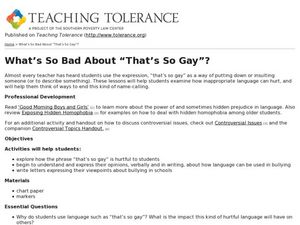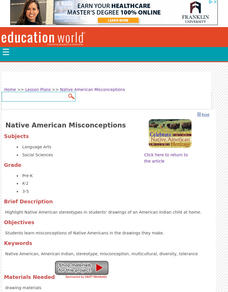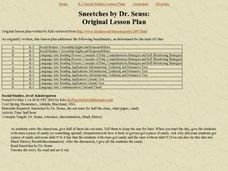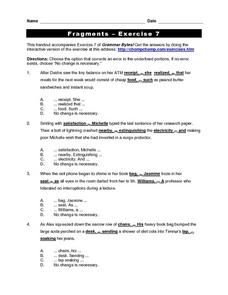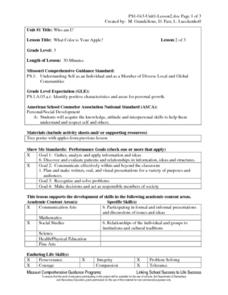Curated OER
What’s So Bad About “That’s So Gay”?
Students explore the concept of inappropriate language. In this prejudice in language lesson plan, students examine how the phrase "That's so gay" is language that hurts others.
Curated OER
That's Not Fair!
Students complete an art project with either great or mediocre supplies and discuss how fair it was that they got the supplies they got. In this fairness lesson plan, students are given supplies by their teacher and discuss how unfair it...
Curated OER
Native American Misconceptions
Learners use their drawings to explore sterotypes of Native Americans and others.
Curated OER
United We Stand
Student examine the life and work of Cesar Chavez. In this Teaching Tolerance lesson, learners read about Cesar Chavez and recognize his work as a labor leader. Students discuss the concept of standing together as a group to fight...
Curated OER
Poverty and Natural Disasters: Exploring the Connections
Students explore the connections between natural disasters and poverty. In this economic lesson students examine worksheets and activities for each level.
Curated OER
My Name is Osama - Bullying and Name-Calling
Students read the story of an Iraqi immigrant boy named Osama who faces taunts of terrorist in his U.S. school after the attack of September 11.
They discuss the characters and their struggles in the story. Students respond to...
Curated OER
Fighting Prejudice and Discrimination against People with Learning Disabilities
Students work to understand learning disabilities and discrimination. In this teaching tolerance lesson, students examine what learning disabilities are and how people are discriminated against. There are different activities...
Curated OER
Children's Books Teach Diversity, Respect
Students compare aspects of children's books that teach diversity and respect. They examine universal values such as courage and bravery, respect and apathy. They create a final project based on their ability to recognize the values in...
Curated OER
Stepping Into Careers
In this career instructional activity, students take a look at the qualities a person must possess in order to be considered a "cooperative person." Students make a record of daily activities showing responsibility at school and home for...
Perfect-English-Grammar.com
Gerunds and Infinitives Part 3
Young grammarians are asked to provide either the correct gerund or infinitive required to complete a series of sentences.
Curated OER
Six Dynamic Designs for Arts Integrated Curriculum
Students create a recipe for a certain aspect of a culture. They create a culture that has never existed before. They analyze either dance, history, geography, history or the future of space exploration. They compare and contrast...
Curated OER
Different! Diverse! Dynamic! What Do Stories Share?
Students compare and contrast the stories, "Leo, the Late Bloomer," and "Thank You, Mr. Falker." They develop a Venn diagram, and write and illustrate the central theme of the stories.
Curated OER
Best Part of Me
Students find the best part of their body. For this positive self-concept lesson, students listen to the story The Best Part of Me. They come up with their best feature and write a poem about it.
Curated OER
Cooperative Comics
Students create comics identifying conflicts and their resolutions. In this conflict resolution lesson, small groups of students follow specific mapping instructions to illustrate a conflict and its resolution. Students present orally...
Curated OER
Sneetches by Dr. Seuss
Students read "Sneetches" by Dr. Seuss. They complete a story map and write about the topic of prejudice. They role-play star-bellied and plain-bellied sneetches and write a persuasive essay about their experiences.
Curated OER
Sneetches by Dr. Seuss:
Students enter the classroom, half of them are given die-cut stars. They are told to keep the star for later. At the start of the day, the students with stars a piece of candy. Students brainstorm how it feels to get/not get a piece...
Curated OER
Description of Personality
In this adjectives online interactive worksheet, students choose the multiple choice adjective that completes 10 sentences correctly. Students choose the opposite of 10 specific adjectives. Students determine which adjective out of two...
Curated OER
The March Continues
Young scholars explore the Civil Rights Memorial. For this character development and U.S. History lesson, students employ reading comprehension strategies while reading a news article about the Civil Rights Memorial. Young scholars work...
Chomp Chomp
Word Choice - Exercise 1: Their, There, and They're
They're going to their house over there. Ah, those pesky homophones! Use this set of 20 fill-in-the-blank questions to assess your classes' skills with the three words there, their, and they're. Practice makes perfect!
Curated OER
Fragments exercise 7
In this grammar instructional activity, students read sentences with underlined parts, determine if the underlined words and punctuation marks contain errors, and if they do, choose the correct option for correcting them. Students answer...
Curated OER
The Shape of Home
Students define home and understand that home is not the same to everyone. In this homes lesson, students participate individually and in groups to create a classroom definition of home. Students discuss the events in the story the Shape...
Curated OER
Good Apples
Students choose an apple from a larger group of apples and examine it closely. They return their apples to the group and then attempt to identify their own. They discuss how this activity applies to human similarities and differences.
Curated OER
What Color Is Your Apple?
Third graders spend time identifying the characteristics they have and ones they would like to develop for their own personal growth. As a class, they brainstorm ways they can tell they are growing up or being mature. Individually, they...
Museum of Tolerance
Cultural Research Activity
Class members explore cultural diversity through a variety of texts that showcase the importance of traditions. Then, they interview their family members to research their own cultural background and write their findings on quilt...
